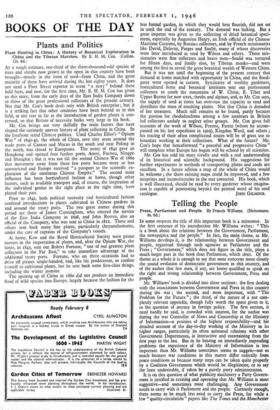BOOKS OF THE DAY
Plants and Politics
AT a rough estimate, one-third of the three-thousand-odd species of trees and shrubs now grown in the open in this country have been brought—mostly in the form of seed—from China, and the great majority of these have arrived during the last eighty years. It does not need a Fleet Street reporter to scent " a story " behind these bald facts, and now, for the first time, Mr. E. H. M. Cox has given us this story, from the early days of the East India Company down to those of the great professional collectors of the present century. Not that Mr. Cox's book deals only with British enterprise ; but it is a striking fact that other countries have been behind us in this field, at any rate as far as the introduction of garden plants is con- cerned, so that Britain of necessity bulks very large in his book.
Mr. Cox brings out very skilfully the main factors that have shaped the curiously uneven history of plant collecting in China. In the forefront stand Chinese politics. Until Charles Elliot's " Opium War." of 1840-42, the whole of China, save tiny areas around the trade ports of Canton and Macao in the south and near Peking in the north, was closed to Europeans. The treaty of 1842 gave us Hongkong and opened four further ports, Amoy, Fuchou, Ningpo and Shanghai ; but it was not till the second Chinese War of 186o that movement away from these few ports became more or less unrestricted and Europe received " a passport to the scientific ex- ploration of the enormous Chinese Empire." The second main influence has been horticultural fashion at home, though other factors, such as available transport and, of course, the inspiration of the individual genius in the right place at the right time, have played their part.
Prior to 1842, both political necessity and horticultural fashion confined introductions to plants cultivated in Chinese gardens in and around the treaty ports. The two great names during this period are those of James Cunningham, who entered the service of the East India Company in 1698, and John Reeves, also an official of the Company, who was sent to China in 1812. These and others sent back many fine plants, particularly chrysanthemums, under the care of captains of the Company's vessels.
At home, Kew and the Royal Horticultural Society were prime movers in the importation of plants, and, after the Opium War, the latter, in 1843, sent out Robert Fortune, " one of our greatest plant collectors in the Far East," to take immediate advantage of the additional treaty ports. Fortune, who on three occasions had to drive off pirates single-handed, had, like his predecessor, to confine himself to cultivated plants, but he sent back some first-class things, including the winter jasmine. The opening up of China in 186o did not produce an immediate flood of wild species into Europe, largely because the fashion for the less formal garden, in which they would best flourish, did not set in until the end of the century. The demand was lacking. But a great impetus was given to the collecting of dried botanical speci- mens, especially by Augustine Henry, an Irish official of the Chinese Maritime Customs, by Russiaa collectors, and by French missionaries like David, Delavay, Farges and Soulie, many of whose discoveries were later introduced as seed by Wilson and others. These mis- sionaries were fine collectors and brave men—Soulie was tortured for fifteen days, and finally shot, by Tibetan monks—and were among the first to reveal the great botanical wealth of Western China.
But it was not until the beginning of the present century that demand at home marched with opportunity in China, and the flood- gates were opened in earnest. Syndicates of wealthy gardeners, horticultural firms and botanical institutes sent out professional collectors to comb the mountains of W. China, E. Tibet and Upper Burma for new trees, shrubs and alpines, and, as Mr. Cox says, the supply of seed at times has over-run the capacity to tend and distribute the mass of resulting plants. Not that China is denuded of her treasures. Much still remains to be found, partly because the passion for rhododendrons among a few amateurs in Britain led collectors unduly to neglect other groups. Mr. Cox gives full accounts of the work of Wilson, Forrest, Farrer (whom he accom- panied on his last expedition in 1919), Kingdon Ward, and others ; his tracing of their often complicated routes will be of great use to botanists working at their collections. What of the future? Mr. Cox's hope that henceforward " a peaceful and progressive China " will complete what Europe has begun will be echoed by all scientists.
Mr. Cox has told his story vividly and with a real understanding of its historical and scientific background. His suggestions for further experiments in methods of transporting plants and seeds are excellent. In a future edition a map of the whole of China would be welcome ; the three existing maps could be improved, and a few misprints and inconsistencies in the text corrected. His book, which is well illustrated, should be read by every gardener whose imagina- tion is capable of penetrating beyond the printed word of his seed


























 Previous page
Previous page